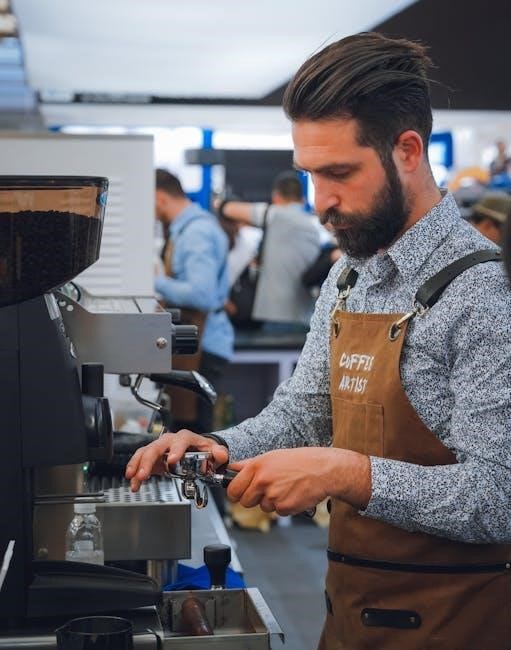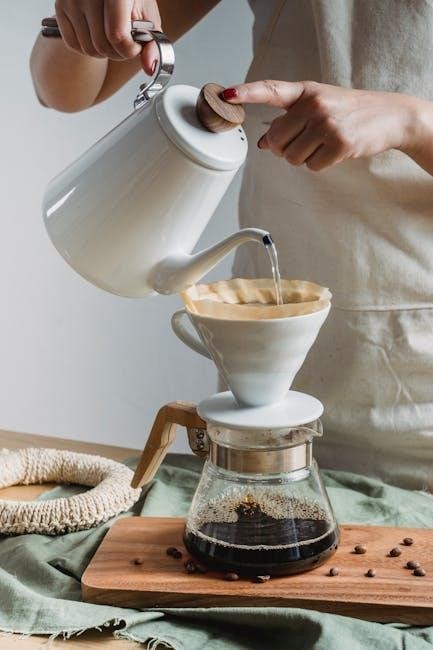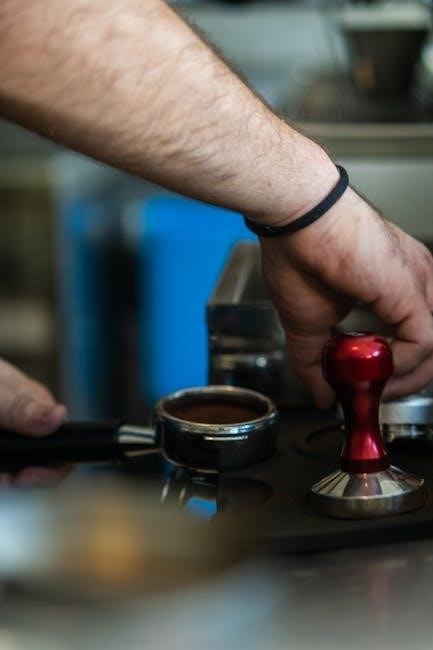Manual pour-over is a traditional coffee brewing method that offers precise control over flavor and texture, fostering a deeper connection to the coffee experience.
1.1 What is Manual Pour-Over?
Manual pour-over is a coffee brewing method where hot water is manually poured over ground coffee beans in a filter, allowing precise control over extraction, flavor, and aroma. This technique emphasizes the connection between the brewer and the coffee, offering a clean and nuanced cup through its straightforward yet deliberate process.
1.2 Brief History of Manual Pour-Over
Manual pour-over coffee brewing traces its origins to the early 1900s, with Melitta Bentz inventing the first pour-over device in 1908. Her porcelain filter design improved cleanliness and flavor. The method gained popularity in the mid-20th century, particularly in Japan, where it became a staple in coffee culture, symbolizing simplicity and artisanal craftsmanship.
1.3 Popularity of Manual Pour-Over in Coffee Culture
Manual pour-over has surged in popularity due to its simplicity and ability to yield high-quality, customizable brews; It’s a favorite among coffee enthusiasts and cafes, symbolizing a return to artisanal methods. The process emphasizes precision, allowing for nuanced flavor extraction, making it a cornerstone of modern coffee culture and a celebrated brewing tradition worldwide.

Equipment Needed for Manual Pour-Over
Manual pour-over requires essential tools like a dripper, filters, kettle, grinder, and scale. These components ensure precision and consistency, enhancing the brewing experience.
2.1 Coffee Dripper (e.g., Hario V60, Chemex)
The coffee dripper is central to pour-over brewing. Popular options like the Hario V60 and Chemex are known for their design and functionality. The V60’s cone shape allows for clean extraction, while the Chemex’s thick glass and unique filter produce a smooth, balanced cup. Both are beloved by coffee enthusiasts for their durability and versatility.
2.2 Coffee Filters
Coffee filters are essential for pour-over brewing, available in paper or metal. Paper filters absorb oils and sediment, yielding a clean cup, while metal filters allow oils and particles through for a bolder flavor. Regularly replacing filters ensures optimal taste and prevents residue buildup, enhancing the overall brewing experience.
2.3 Kettle
A kettle is a crucial tool for manual pour-over, providing hot water at the ideal temperature. Gooseneck kettles are preferred for their precision in pouring. Stainless steel or electric kettles are popular choices, offering durability and temperature control, ensuring consistent water flow for optimal extraction and flavor in every brew.
2.4 Coffee Grinder
A coffee grinder is essential for manual pour-over, allowing precise control over grind size. Burr grinders are preferred for consistent particle distribution, while blade grinders are more affordable but less precise. Freshly grinding beans ensures optimal flavor extraction, making it a key step in achieving a high-quality pour-over coffee experience every time.
2.5 Scale
A scale is crucial for precise measurements in manual pour-over. It ensures the perfect coffee-to-water ratio, allowing for consistent brewing. Digital scales offer greater accuracy, enabling precise control over the amount of coffee and water used, which is vital for achieving a balanced and flavorful cup of coffee every time.

The Brewing Process
Manual pour-over brewing involves carefully pouring hot water over ground coffee beans in a filter, allowing for precise control over extraction and a nuanced flavor profile.
3.1 Step-by-Step Guide to Brewing
Brewing manual pour-over involves heating water, preparing the filter, adding coffee grounds, and slowly pouring water in stages. Start with a bloom phase, then pour in circular motions, ensuring even extraction. Monitor the process to achieve the perfect balance of flavors and aromas in your cup.
3.2 Importance of Water Temperature
Water temperature is crucial for optimal extraction. The ideal range is 195°F–205°F. If too high, it burns the coffee, leading to bitterness. If too low, extraction is incomplete, resulting in a weak or under-extracted brew. Proper temperature ensures a balanced extraction, enhancing both aroma and flavor in your manual pour-over coffee.
3.3 Role of Coffee-to-Water Ratio
The coffee-to-water ratio is essential for achieving balanced extraction. A general guideline is 1:16 to 1:17 (coffee to water). Adjusting this ratio tailors the brew’s strength and flavor to personal preference, ensuring the coffee is neither under-extracted nor over-extracted, which is vital for a perfect manual pour-over experience.
Understanding Coffee Beans
Coffee beans are the heart of pour-over brewing, with Arabica and Robusta being the most common. Their origin, roast level, and processing methods significantly impact the final flavor profile.
4.1 Choosing the Right Coffee Beans
Selecting the right coffee beans for manual pour-over involves considering factors like bean origin, roast level, and processing methods. Lighter roasts offer brighter, more complex flavors, while darker roasts provide a bolder, smoother taste. Fresh, high-quality beans are essential for optimal extraction and a vibrant cup. Experiment with different varieties to find your preference.
4.2 Roast Levels and Their Impact on Flavor
Roast levels significantly influence the flavor profile in manual pour-over. Lighter roasts offer brighter acidity and nuanced, floral notes, while medium roasts balance acidity with chocolatey undertones. Darker roasts provide bold, smoky flavors with reduced acidity. The roast level affects extraction, making it crucial to choose a bean that complements your brewing technique and taste preferences effectively.
Tips for the Perfect Manual Pour-Over
Mastering manual pour-over requires attention to water temperature, even coffee ground distribution, and precise pouring techniques to ensure a balanced and flavorful extraction every time.
5.1 Preparing Your Equipment
Before brewing, rinse the filter with hot water to remove any paper taste and preheat the dripper and server to ensure consistent temperature. Grind your coffee beans just before use for optimal freshness and aroma, storing them properly to maintain quality.
5.2 Blooming Coffee
Blooming coffee involves pouring a small amount of hot water over the grounds to release trapped gases, ensuring even extraction. Typically, 30-40 ml of water is used, allowing the coffee to “bloom” for 30-45 seconds. This step prevents channeling and ensures all grounds are saturated, enhancing flavor and aroma.
5.3 Pouring Techniques
Pouring techniques are crucial for even extraction. Start with a circular motion, evenly saturating all grounds. Use pulse pouring—short pours followed by pauses—to avoid channeling. Maintain a steady flow rate and height to ensure balanced extraction, enhancing flavor and body for a refined, professional-quality cup of coffee.

Common Mistakes to Avoid
Common mistakes include inconsistent water temperature, uneven coffee grounds, and improper pouring techniques. Avoid using too much or too little coffee, and ensure the filter is properly seated.
6.1 Incorrect Water Temperature
Using water that’s too hot or cold can significantly impact flavor. Ideal temperature is between 195°F and 205°F. Too hot risks burning coffee, while too cold leads to under-extraction. Always use a thermometer to ensure accuracy and avoid this common mistake for a balanced brew.
6.2 Uneven Coffee Grounds
Uneven coffee grounds can lead to inconsistent extraction, affecting flavor. Fine and coarse particles cause channeling and under-extraction. Use a burr grinder for uniform grinds and level the bed before brewing to ensure even saturation and a balanced cup.
6.4 Over- or Under-Extraction
Over-extraction leads to bitter flavors, while under-extraction results in sour or weak coffee. Both occur due to incorrect water temperature, grind size, or steeping time. Adjusting these variables ensures balanced extraction, optimizing flavor and aroma for a perfect cup.
Comparison with Other Brewing Methods
Manual pour-over offers more control over brewing parameters compared to drip coffee and French press, resulting in a cleaner and more customizable cup.
7.1 Manual Pour-Over vs. Drip Coffee
Manual pour-over brewing provides greater control over variables like water temperature and coffee-to-water ratio compared to drip coffee, which is automated. This customization leads to a more flavorful and nuanced cup, while drip coffee is convenient but less precise in extraction. Pour-over also avoids potential paper filter taste found in some drip brewers.
7.2 Manual Pour-Over vs. French Press
Manual pour-over and French Press differ in extraction methods. Pour-over uses gravity to slowly drip water through grounds, offering a clean, bright flavor. French Press steeps coarse grounds in hot water, resulting in a richer, bolder coffee with more oils and sediment. Both methods highlight distinct flavor profiles but cater to different tastes and preferences effectively.

Advanced Techniques
Advanced techniques refine the pour-over process, emphasizing precision and creativity. These methods enhance flavor extraction and personalization for coffee enthusiasts seeking a tailored brewing experience.
8.1 Adjusting Brewing Time
Adjusting brewing time allows customization of extraction levels. Shorter times yield brighter, acidic notes, while longer times enhance body and sweetness. Experimenting with timing helps achieve the desired flavor profile, ensuring each cup is tailored to personal preference without compromising quality. This technique is key for refining the pour-over method effectively.
8.2 Experimenting with Ratios and Grinds
Exploring different coffee-to-water ratios and grind sizes can significantly impact flavor. A finer grind may increase extraction, while a coarser grind reduces it. Ratios like 1:15 or 1:17 allow for tailored strength. Adjusting these variables helps in achieving the perfect balance of flavors, making each brew uniquely satisfying and personalized to taste preferences.
Health Benefits of Manual Pour-Over Coffee
Manual pour-over coffee offers health benefits by allowing control over ingredients, reducing caffeine content, and using fresh, high-quality beans without additives, promoting a healthier brewing option.
9.1 Control Over Ingredients
Manual pour-over brewing provides complete control over ingredients, allowing users to select high-quality coffee beans, adjust grind size, and use filtered water, ensuring a pure and customizable coffee experience without additives or preservatives.
9.2 Lower Caffeine Content
Manual pour-over brewing often results in lower caffeine content compared to other methods, as it allows precise control over steeping time and coffee-to-water ratio, minimizing extraction and providing a smoother, less bitter coffee experience suitable for those sensitive to caffeine.
Maintenance and Cleaning
Regular cleaning of equipment and proper storage of coffee beans are essential for maintaining flavor and longevity, ensuring a consistently high-quality manual pour-over coffee experience.
10.1 Cleaning the Equipment
Regularly clean your pour-over equipment with warm water and mild detergent to remove residual coffee oils. Rinse thoroughly to prevent any soapy residue from affecting the taste. For glass or ceramic drippers, avoid harsh chemicals, as they can leave unwanted flavors. Dry the equipment after cleaning to maintain hygiene and prevent water spots or mineral buildup.
10.2 Storing Coffee Beans
Store coffee beans in an airtight container in a cool, dark place to preserve freshness. Avoid heat sources and direct sunlight. For longer storage, freeze in airtight containers but in small batches to maintain flavor. Regularly refresh your supply to ensure optimal taste and aroma when brewing manual pour-over coffee.
Regional Variations
Manual pour-over techniques vary globally, reflecting local coffee cultures. Japanese and Scandinavian methods are particularly renowned, emphasizing precision, simplicity, and unique cultural influences on brewing traditions.
11.1 Japanese-Style Pour-Over
Japanese-style pour-over is known for precision and ceremony. Using tools like Hario V60, it emphasizes water temperature, pouring technique, and bean quality. The process is meditative, yielding clean and nuanced coffee. This method reflects Japan’s deep coffee culture, blending tradition with modern craftsmanship, ensuring each cup is a perfect balance of art and flavor.
11.2 Scandinavian Coffee Traditions
Scandinavian coffee traditions emphasize simplicity and quality, with a focus on light roasts and clean brewing methods. Pour-over is popular, often served with traditional pastries and bread. The cultural practice of “fika” encourages socializing over coffee, reflecting a lifestyle that values mindfulness and community. This approach balances richness and brightness, embodying Nordic values of minimalism and harmony.
Mastering manual pour-over offers a rewarding coffee experience, blending artistry and precision. It allows for a deeper connection to the craft, ensuring every sip is uniquely satisfying.
12.1 Final Thoughts on Manual Pour-Over
Manual pour-over brewing is a simple yet rich method that offers full control over flavor and aroma. It allows coffee enthusiasts to craft each cup to their liking, ensuring a satisfying and personalized experience. This traditional technique balances simplicity with sophistication, making every pour a delightful ritual for coffee lovers.
12.2 Encouragement to Try Manual Pour-Over
Give manual pour-over a try for its simplicity and precision. It’s a rewarding process that connects you with your coffee, offering a sensory experience and a perfectly tailored cup. Embrace the ritual, experiment with flavors, and enjoy the satisfaction of crafting your coffee just the way you like it every time.
